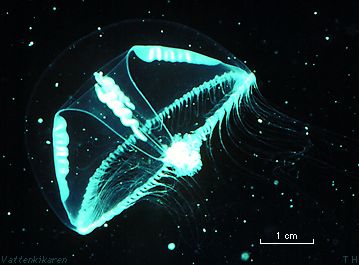|

Distribution in scandinavian waters
|
Maximum diameter: About 20 cm, but on exceptional
occasions up to 30 cm.
Appearance: The mouth is situated at the top of the tubular formation
that hangs down from the underside of the "umbrella". Along the inside
edge of the "umbrella" is a peripheral crease and the tentacles hang
down from the "umbrellas" outer edge. The leptomedusae have many tentacles,
the number of which increase with age. The "umbrella" form is rather
shallow, and on the underside, the organs that produce eggs and sperms
are situated. The leptomedusae are usually transparent, but on occasions
can be milky white or have a light blue, brown, red or violet tone.
Even with transparent medusae, the sexual organs, stomach and tentacles
can be light red, greenish or light brown.
Compare the leptomedusae with the anthomedusae
and the moon
jellyfish.
Depth: From sea-level to unknown depth.
Environment: Pelagic.
Misc: The leptomedusae catches and eats small organisms and suspended
remains from the surrounding water. These medusae do not sting enough
to cause discomfort to people. Medusae representatives are found globally.
The medusa stage is part of a life
cycle where even an attached
stage is present and the medusae build colonies.
Classification: The above photo shows a jellyfish (Tima bairdii).
Leptomedusae are part of the hydroid,
group under the cnidarians.
|


